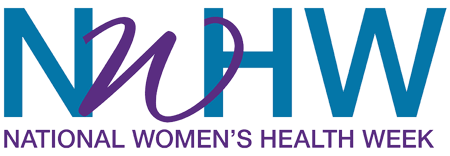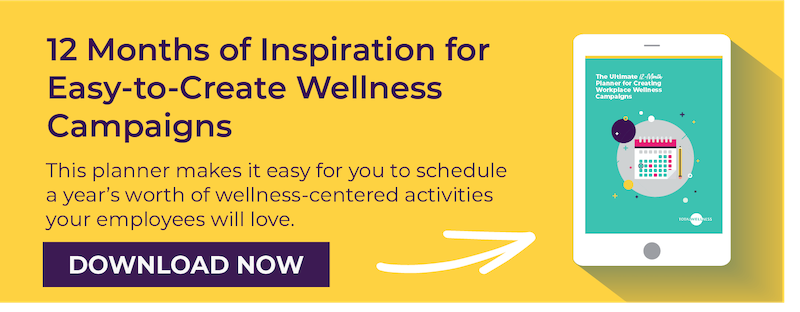 Mother’s Day weekend kicks off National Women’s Health Week.
Mother’s Day weekend kicks off National Women’s Health Week.
But it’s not only mothers who need to keep an eye on their health. Given that the average American woman lives to age 81, staying healthy should be a priority for all females who want a high quality of life.
National Women’s Health Week — which runs from May 9 to 15, 2021 — is the ideal time to encourage women’s wellness in both the workplace and at home.
By 2050, it’s expected 92 million women will be a part of the traditional workforce, according to the Bureau of Labor Statistics. Right now, nearly 50% of the workforce is made up of women, making this a wellness topic that needs coverage in the workplace.
Help the women in your company take the step to better health this week.
Give the women in your workplace a reminder that their health matters.
Below, you’ll find tips and reminders specific to women’s health to share in honor of the health week dedicated to women everywhere.
Health Tips for National Women’s Health Week
Sharing health tips is a great way to kick off this health observance.
For women dealing with underlying health conditions like hypertension, diabetes, cardiovascular and respiratory conditions, it’s important to stay on top of health conditions. Additionally, women 65 years and older should be encouraged to keep a watchful eye on their health.
Here are a few health tips to share with the women in your office:
Tip #1: Eat Well-Balanced Meals
To maintain good health, the female body demands a variety of high-quality minerals and vitamins. When you eat a well-balanced diet, you’re guaranteed to hit all the nutrient groups your body needs. A diet rich in fruits, veggies (especially dark leafy greens), whole grains, and unprocessed foods is the best way to ensure your body gets the right nutrients.
Females need these in particular:
- Vitamin B-12 - This vitamin helps your body make red blood cells. Women who are pregnant, vegetarian, or 50 and older may need additional supplementation.
- Vitamin B9 - This essential vitamin helps create blood cells and the DNA for new cells. It’s necessary for pregnant women so their babies have a healthy birth weight.
- Vitamin D - This vitamin is known to reduce inflammation in your cells. When paired with calcium, it builds strong bones which can prevent concerns like osteoporosis.
- Calcium - Women are at a higher risk for osteoporosis, which is the breaking of fragile bones. The body stores calcium in your bones, but if you don’t get enough, it will take it from your bones, making them prone to breakage. Calcium is also responsible for the communication between the brain and muscles.
- Iron - Since iron is lost during menstrual cycles, iron is an essential part of every woman’s diet. It’s responsible for healthy blood cells that carry oxygen in your body and for making the body’s connective tissue.
Important note: If you deal with constant brain fog, brittle nails, constipation, and fatigue, contact your doctor to get blood work done. You may be missing key nutrients in your system or be dealing with a hormonal imbalance. If everything seems fine with the blood work but you need more answers, you may want to reach out to other sources. A functional medicine-style dietician may be able to pinpoint other problem areas and help you narrow down health concerns.
Tip #2: Maintain Bone Health
Unfortunately, women are more likely to deal with bone fractures than men. In fact, of the estimated 10 million Americans with osteoporosis, about 80% are women, according to the National Osteoporosis Foundation. It’s never too early to start thinking about osteoporosis prevention.
A few ways to prevent bone issues:
- Eat well - As covered above, women need a variety of nutrients and minerals to thrive. Foods rich in calcium and vitamin D are important for the female body, especially the bones. Bok choy, soybeans, and broccoli are jam-packed with calcium. Egg yolks and liver are rich in vitamin D.
- Stay strong - A regular workout routine that includes strength training or resistance training is an excellent way to keep bones strong and healthy. That includes jogging, hiking, and even climbing stairs.
- Cut out tobacco and alcohol use - Research indicates tobacco use may contribute to weak bones. The same is said for more than one daily alcoholic drink a day.
The time period prior to menopause is when women really need to be mindful of their bone strength. The more bone density you have when you reach menopausal years, the lower the chance of osteoporosis developing. Some women can lose up to 20% bone density in the five to seven years that follow menopause.
Tip #3: Check Your Breasts Monthly
A monthly self-breast exam is an important easy and free way to stay on top of breast health. While no exam or equipment will always catch cancer, a combination of self-breast exams and regular check-ups can increase the chances of catching cancer early. Forty percent of diagnosed breast cancers were discovered by women who did their own exams, according to Johns Hopkins Medical center.
How to check for breast lumps:
- Face a mirror - By visually inspecting your breasts frontally, you can see any change in size, shape, or dimpling in the skin. Raise your arms above your head to see if you notice any changes in contour or dimpling.
- In the shower - With your three middle fingers, check the entire breast by pressing down with different pressure levels. Check the armpit area, too. Each breast should be examined monthly for any lump, thickening, hardened knot, or any other breast changes.
- Lie down - Put a pillow under your right shoulder and your right arm behind your head. Using your left hand, move the pads of your fingers around your right breast gently covering the entire breast area and armpit. Switch sides to inspect your left breast as well.
Never hesitate to call your doctor or gynecologist if you suspect a lump or notice a change in your breasts. It’s better to be safe and err on the side of caution. When going in for an examination of a suspicious lump, you can expect your doctor will examine your breasts and take down a family history before ordering further testing, if needed.
Tip #4: Take Care of Your Skin
With the lazy days of summer coming, more time outdoors means staying mindful of regular sunscreen applications. Not only does frequent sun exposure increase the risk of premature skin aging (AKA wrinkles), it also increases the risk of skin cancer. Women who are younger than 49 actually have a higher chance of developing melanoma over any other cancer with the exception of breast or thyroid cancer, according to the John Hopkins Medicine website.
Use the ABCDE method to check for skin cancer:
- Asymmetry: Half the mole doesn’t match the other
- Border: The border of the mole is ragged or irregular
- Colors: The mole is multiple colors
- Diameter: The mole is larger than a pencil eraser
- Evolution: The mole is changing, getting larger or bleeding
If you notice any of the above changes, get to the dermatologist ASAP. Additionally, the daily use of a broad-spectrum that’s SPF 30 or higher can protect your skin from damaging UV rays. Avoid the sun midday and wear a hat and sunglasses to protect yourself from skin damage.
Tip #5: Prioritize Sleep
While most women get about 11 more minutes of sleep than men, research shows they tend to get lower-quality sleep. One theory is that women take on more caregiver roles, which can interrupt sleep more often. Women tend to nap during the day as well, another activity that disrupts quality nighttime sleep, according to the Sleep Foundation.
Ways to get more deep sleep:
- Invest in quality sleep items - A comfortable bed, pillow, and sheets can make all the difference in feeling relaxed enough to get to sleep.
- Skip screen time - An hour before snooze time, shut down all electronics. The blue light from the screens disrupts the release of melatonin, the hormone that makes you feel sleepy.
- Practice good sleep hygiene - Get to bed at the same time each night and wake up at the same time daily. Keep your room cool and quiet with the television off. Reduce nighttime caffeine and alcohol intake, too, to improve sleep patterns.
If sleep disturbances keep you from falling or staying asleep, talk to your doctor. You could be dealing with an underlying sleep disorder that may require medical attention. Quality, deep sleep repairs your body’s cells and also helps to keep your cognitive function sharp, so ensuring regular and deep sleep is a priority!
Tip #6: Stay in Touch With Your Gynecologist
Most women wouldn’t put going to the gynecologist as their favorite to-do list item. But, the few minutes of discomfort is worth it if it can prevent more serious health concerns for your reproductive organs. Pelvic exams and pap smears are used in the detection of a variety of reproductive issues.
Regular exams are helpful in finding:
- Ovarian cysts
- Uterine fibroids
- Early-stage cancer
- Sexually transmitted infections
Your physician will have an immediate idea of anything serious, but will also confirm irregular results with further testing. Ask your doctor how often they would recommend a pelvic exam. Every woman is different and it will be based on her health history and symptoms.
Engage Your Team in National Women's Health Week
This week is the ideal time to bring women’s health issues into the spotlight. There are a variety of ways to highlight women’s health and remind your female employees to take care of their health.
Here are some ways to participate in National Women’s Health Week:
- Share this list - One of the easiest ways to participate is to share the list above of important health tips women may need to be reminded about.
- Encourage a MinuteClinic visit - During the week of May 9-15, women can get a no-cost heart health screening at any CVS location that has the clinic. Encourage the females in your office to go get one done! Download the free voucher here.
- Organize events - Plan female-centered health activities and initiatives in your community or in the workplace.
- Host a mammogram mobile - If your workplace has space, consider bringing in a mammogram mobile to make it easier for the females in your workplace to get a breast cancer screening.
- Promote it via company social media channels - Use NWHW promotional tools on social media. Use #NWHW in social media messages you share.
How will you promote National Women’s Health Week in your workplace? Let us know in the comments below!
Want to help your team develop better habits? Check out our free resource Building Healthy Habits and download it today!



